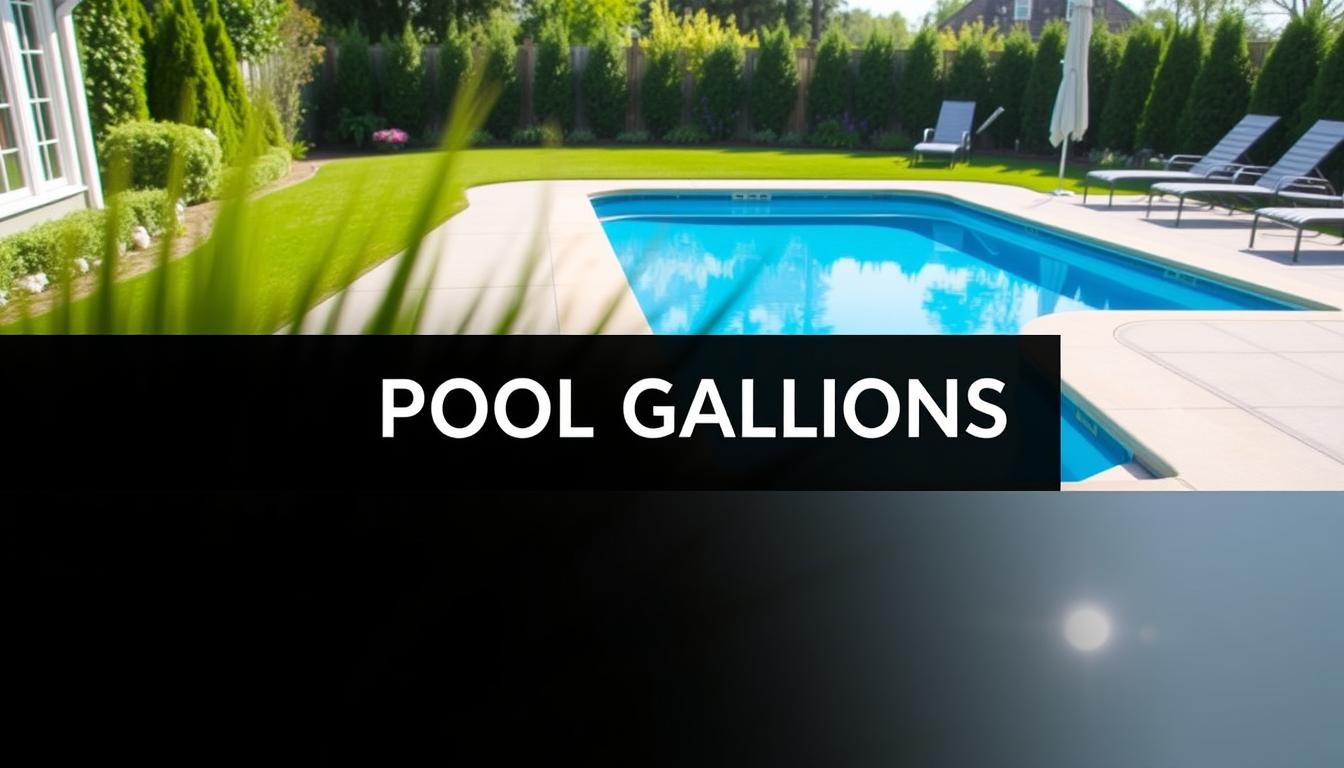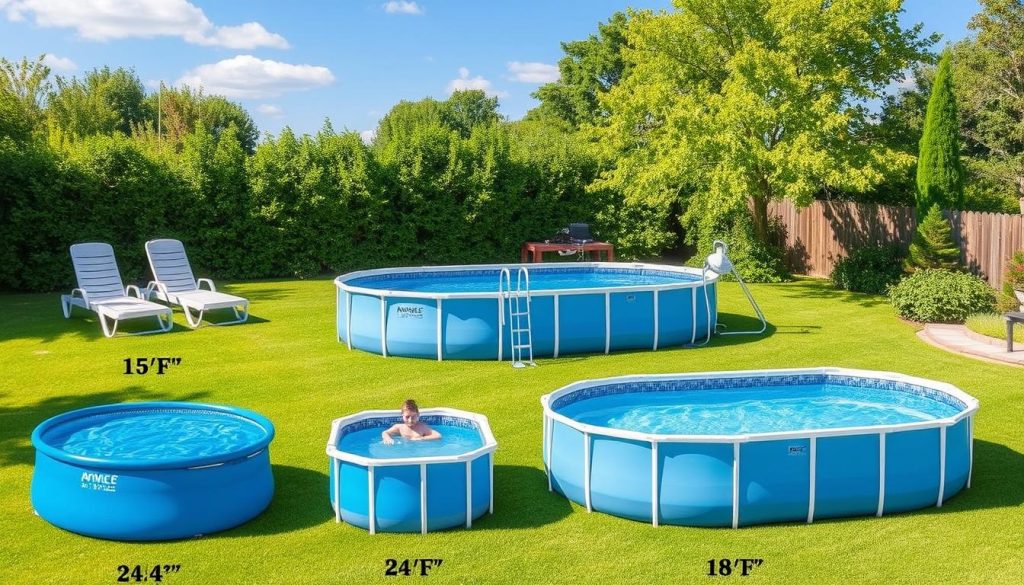
The average backyard pool in the US holds about 22,000 gallons. That’s enough to fill over 400 bathtubs! Knowing your pool’s volume is key for good maintenance and cost control.
Pool volume is crucial for water quality and equipment selection. Let’s explore how many gallons are in typical pool sizes.
Pool size in gallons varies based on type, shape, and depth. Above-ground pools usually range from 10 to 24 feet across. Inground pools often measure between 10 x 20 feet and 20 x 40 feet.
Pool depth greatly affects its volume. Shallow pools hold less water than deeper ones. This factor is important when calculating total gallons.
Key Takeaways
- The average backyard pool capacity in the US is around 22,000 gallons
- Knowing your pool’s volume is essential for maintaining water quality and managing costs
- Pool volume varies based on factors such as pool type, shape, and depth
- Above-ground pools typically range from 10 to 24 feet in diameter
- Inground pools commonly fall between 10 x 20 feet and 20 x 40 feet
- Shallower pools hold less water than deeper ones
Understanding Swimming Pool Volume
Pool volume is crucial for pool owners. It affects construction, maintenance, and swimmer safety. Knowing your pool’s water capacity helps with proper chemical balance and maintenance.
Definition and Significance of Pool Volume
Pool volume is the total water a pool can hold. It’s measured in gallons or cubic meters. To calculate volume, multiply cubic feet by 7.48.
A pool 26 feet long, 13 feet wide, and 4.60 feet deep holds about 11,834 gallons. Knowing volume helps choose the right equipment and chemicals.
It ensures proper circulation and filtration. Volume awareness is vital for safety compliance and optimal pool design.
Impact on Construction and Maintenance Costs
Pool volume affects construction and maintenance costs. Larger pools need more materials and labor, increasing expenses. They also require more chemicals and filtration for upkeep.
Proper chemical balance prevents health issues and extends pool component life. Over 4,500 people visit the ER yearly due to improper chemical balance.
Using a pool gallon calculator helps apply correct chemical dosages. This reduces skin irritation risk and damage to pool surfaces and equipment.
Mastering pool volume calculation enhances pool maintenance effectiveness through precise measurement, leading to well-balanced chemical dosages, efficient filtration, and overall improved swimming experience.
Knowing pool volume aids in efficient maintenance and cleaning. It helps determine correct chemical dosages and cleaning frequency. Reducing pool water volume has several benefits.
These include lower environmental impact, cost savings, and reduced energy use. It also makes maintenance easier and improves water chemistry balance.
| Pool Size | Wall Height | Water Volume (Gallons) |
|---|---|---|
| 15′ Round | 52″ | 5,724 |
| 18′ Round | 54″ | 8,565 |
| 24′ Round | 54″ | 15,227 |
| 30′ Round | 54″ | 23,793 |
| 33′ Round | 54″ | 28,789 |
| 21′ x 43′ Oval | 54″ | 30,395 |
Pool volume is key for estimating pool water capacity and maintaining chemical balance. It ensures swimmer safety and enjoyment. Accurate calculations help optimize your pool’s performance and longevity.
Calculating Pool Volume: Methods and Tools
Knowing your pool’s volume is key for proper maintenance and cost planning. This guide explores various methods to calculate pool volume accurately. With this info, you can keep your pool in top shape.
Geometric Formulas Based on Pool Shape
Geometric formulas are a common way to calculate pool volume. These use the pool’s dimensions to determine volume in gallons or cubic meters.
Here are formulas for standard pool shapes:
| Pool Shape | Formula |
|---|---|
| Rectangular | Volume = Length × Width × Average Depth × 7.48 |
| Circular | Volume = 3.14 × Radius² × Average Depth × 7.48 |
| Triangular | Volume = Length × Width × 0.5 × Average Depth × 7.48 |
| Oblong | Volume = Length × (Short Width + Long Width) × 0.45 × Average Depth × 7.48 |
Measure your pool’s dimensions carefully. Calculate average depth by measuring at various points. Divide the sum by the number of measurements.
Advanced Pool Volume Calculators and Mobile Applications
For an easier approach, try advanced pool volume calculators and mobile apps. These tools let you input pool dimensions and shape. They then calculate the volume automatically.
Popular apps include Pool Calculator by Pentair and Pool Math by Orenda Technologies. These make it simple to determine your pool’s volume. This helps with water chemistry and maintenance planning.
Measuring Depth for Accurate Volume Calculation
Accurate depth measurements are crucial for reliable volume calculations. Use a sturdy tape measure or specialized pool depth tool. Take measurements at various points around the pool.
Include shallow and deep ends, steps, and slopes. Account for any variations in the pool floor’s contours. Calculate average depth by adding all measurements and dividing by the number taken.
Use this average depth in formulas or calculators to find total pool volume.
Accurate pool volume calculation is vital for proper pool care. Use geometric formulas, calculators, or apps with precise measurements. This helps pool owners make informed decisions about care and upkeep.
Common Pool Sizes and Their Gallon Capacities
Pool size affects water capacity, maintenance, and costs. Let’s explore common pool sizes and their gallon capacities. This info helps you choose the right pool for your backyard.

Above-Ground Pool Sizes and Gallons
Above-ground pools are affordable and easy to install. They come in round or oval shapes. Sizes range from 15 to 33 feet in diameter.
Wall heights are typically 52 to 54 inches. Here are some common above-ground pool sizes and their gallon capacities:
| Pool Size | Wall Height | Gallon Capacity |
|---|---|---|
| 15′ Round | 52″ | 5,724 |
| 18′ Round | 54″ | 8,565 |
| 24′ Round | 54″ | 15,227 |
| 30′ Round | 54″ | 23,793 |
| 15′ x 30′ Oval | 54″ | 15,147 |
| 18′ x 33′ Oval | 54″ | 19,994 |
Inground Pool Sizes and Gallons
Inground pools offer more customization options. They blend well with your backyard landscape. These pools come in various shapes like rectangular, oval, kidney, and freeform.
Here are common inground pool sizes and their gallon capacities:
| Pool Size | Shape | Gallon Capacity |
|---|---|---|
| 12′ x 24′ | Rectangular | 10,800 |
| 16′ x 32′ | Rectangular | 19,200 |
| 18′ x 36′ | Oval | 21,700 |
| 20′ x 38′ | Kidney | 20,200 |
| 20′ x 40′ | Rectangular | 30,000 |
How Many Gallons is the Average Pool?
The average U.S. residential pool holds 20,000 to 30,000 gallons. Inground pools usually have a higher capacity than above-ground ones. An average above-ground pool contains about 7,000 gallons.
A typical backyard inground pool holds between 25,000 and 30,000 gallons. Larger pools in hotels or resorts can hold 80,000 to 500,000 gallons.
The Importance of Knowing Your Pool’s Volume
Knowing your pool’s volume is key for proper maintenance and safety. It helps you pick the right equipment and maintain chemical balance. With this info, you can choose the best filters, pumps, and heaters for your pool.
Accurate volume calculations ensure correct chemical dosages. This prevents over or under-treatment of the water. It creates a healthy and safe swimming environment for everyone.
Pool volume knowledge aids in setting up cleaning schedules. This includes how often to backwash, vacuum, and skim. Regular cleaning keeps your pool looking great and extends equipment life.
Understanding pool volume is crucial for swimmer safety. It helps maintain ideal pH, chlorine, and alkalinity levels. This prevents skin and eye irritation and protects against waterborne illnesses.
Knowing your pool’s volume also helps you follow local safety rules. These regulations often relate to pool design and upkeep. By complying, you ensure a safe and enjoyable experience for all swimmers.







